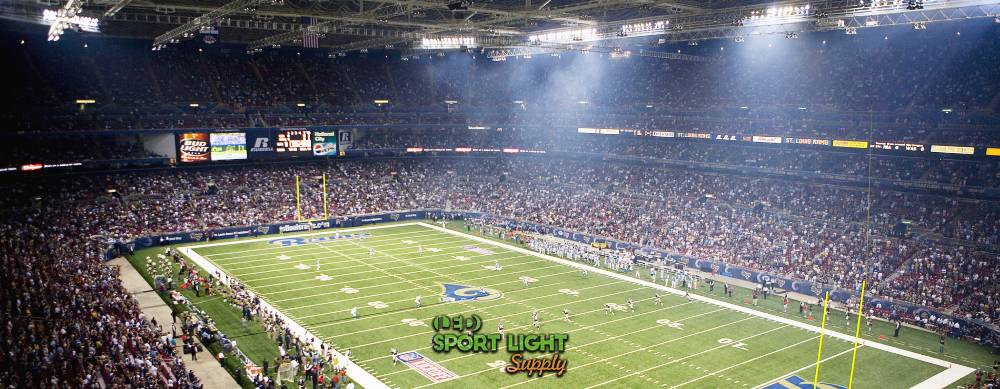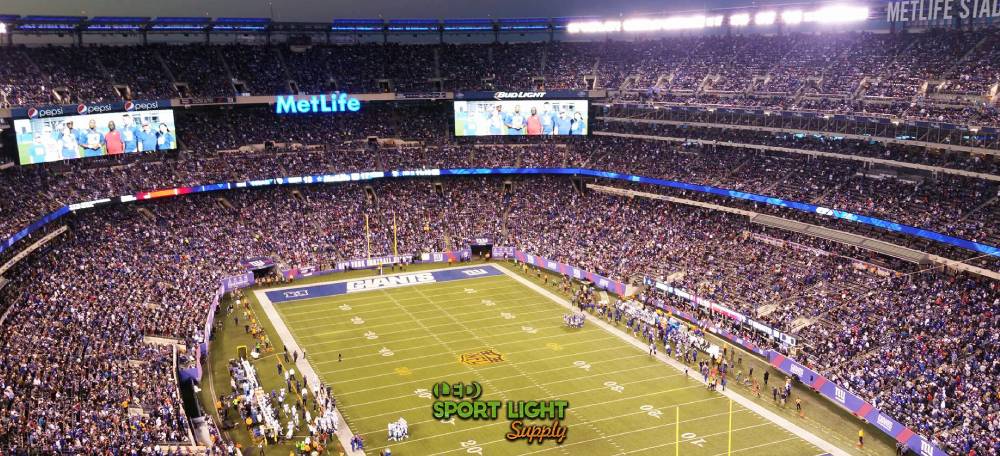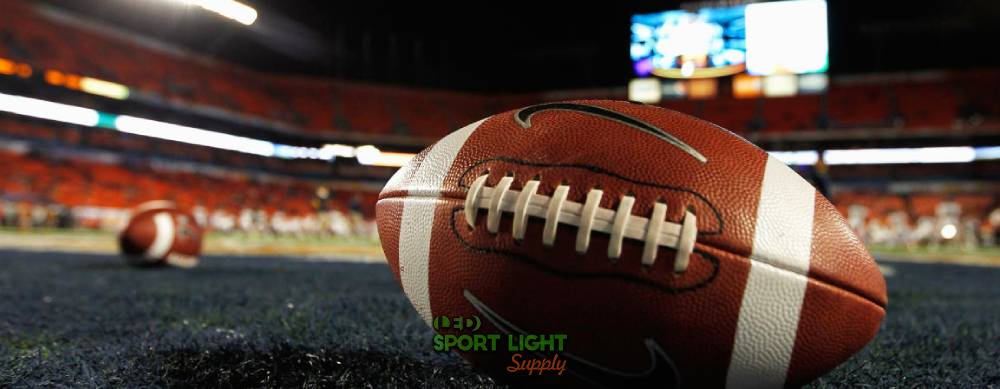Table of Contents
ToggleUnderstanding the Scope of Lighting Fixtures
| Feature | Traditional (Metal Halide) | LED |
|---|---|---|
| Typical Fixture Cost | $300 – $500 per unit | $1,200 – $3,000 per unit |
| Fixture Wattage | 1,500W | 600W – 1,500W |
| Lumen Output | 90,000 – 110,000 | 60,000 – 120,000 |
| Lifespan | 6,000 – 10,000 hours | 50,000 – 100,000 hours |
| Annual Energy Use (40 fixtures, 300 hours) | 18,000 kWh | 12,000 kWh |
| Annual Energy Cost (@ $0.12/kWh) | $2,160 | $1,440 |
| Maintenance Cost Over 10 Years | $5,000 – $10,000 | Minimal |
| Warranty | 1 – 3 years (limited) | 5 – 10 years (standard) |
The Role of Fixtures in Field Illumination
Lighting fixtures are the core components responsible for distributing light across the football field. Their design, type, and quality influence the overall illumination, efficiency, and lifespan of the lighting system. These components house the lamps or LEDs, provide the necessary optical control, and support efficient heat dissipation. The selection of fixtures involves considerations of lumen output, beam angle, durability against environmental conditions, and compatibility with the chosen lighting technology, whether it’s LED or metal halide.

Material and Design Impact on Fixture Costs
The materials used in manufacturing fixtures play a direct role in their pricing. Aluminum is one of the most common materials for housing due to its balance between weight, strength, and corrosion resistance. For outdoor sports lighting, die-cast aluminum enclosures are widely used and typically cost around $50 to $150 more per fixture compared to steel or composite alternatives. Its lightweight properties reduce load on mounting structures and simplify installation, which can also contribute to savings in labor and hardware.
High-performance optical lenses—crafted from polycarbonate or borosilicate glass—are engineered to control beam spread, minimize glare, and achieve consistent light distribution across the entire playing surface. Sports field lighting often requires tight beam angles of 15 to 60 degrees to meet horizontal and vertical illuminance ratios recommended by organizations such as the IES (Illuminating Engineering Society) or local athletic associations. Fixtures incorporating these precision optics can cost between $1,200 and $2,000 each, depending on lumen output and manufacturer.
Weather-sealed housings rated IP65 or higher are standard for football field lighting. Seals, gaskets, and venting systems protect against moisture, dust, and extreme temperature fluctuations. The need for robust environmental protection increases both manufacturing complexity and cost. Additional design elements, like integrated cooling fins for thermal management and brackets for precise angle adjustment, further push pricing upward. These design choices mean sports-specific fixtures can cost 30% to 60% more than general-purpose outdoor area lighting.
The increased price reflects not only the added material costs but also the rigorous design standards needed to ensure long-term reliability and consistent illumination throughout the life of the fixture, often rated at 50,000 to 100,000 hours for LED-based systems.
Comparing Traditional and LED Fixture Pricing

Traditional fixtures using high-intensity discharge (HID) lamps, such as metal halide or high-pressure sodium, have long been used in football field lighting. A typical 1500-watt metal halide fixture costs around $300 to $500 per unit. However, these systems require more frequent lamp replacements, generally every 6,000 to 10,000 hours, and experience significant lumen depreciation over time. The need for warm-up time and the inefficiency of ballast systems also add to their operational drawbacks.
In contrast, LED fixtures designed for sports fields range in cost from $1,200 to $3,000 per unit, depending on wattage (typically between 600W to 1500W), brand, and features such as dimming capability or smart controls. High-output LED floodlights delivering 60,000 to 120,000 lumens are common in football applications and offer better color rendering and beam control than their HID counterparts.
Although the upfront cost of LED fixtures can be two to three times higher than traditional metal halide systems, the financial model shifts when considering lifecycle cost. For example, a metal halide system for a standard football field requiring 30–40 fixtures may cost $15,000 in equipment, but add another $5,000–$10,000 every few years in replacement lamps and labor. An equivalent LED setup might cost $60,000 to $90,000 upfront but has minimal maintenance costs and can cut energy consumption by 50–70%.
An LED fixture rated at 1,000W will consume approximately 1 kWh per hour. Over a season of 300 hours of lighting use, each fixture uses 300 kWh. Multiplied across a 40-fixture system, that’s 12,000 kWh. At an electricity rate of $0.12 per kWh, the energy cost is $1,440 per year. A comparable metal halide system, drawing 1,500W per fixture, would consume 18,000 kWh per season and cost $2,160 annually. Over a decade, that energy difference alone can recoup a large portion of the LED investment.
Moreover, LED systems often come with warranties between five and ten years, reducing risk and minimizing unexpected costs. Metal halide systems, by contrast, frequently require ongoing investment in replacement ballasts and ignitors, which further reduces their long-term appeal despite a lower initial cost.
Overall, the price gap between traditional and LED fixtures is closing as technology improves and economies of scale reduce LED costs. Still, for football field projects with limited capital, upfront costs often drive decision-making. In such cases, long-term savings and reduced maintenance downtime make a compelling case for choosing LED despite the higher price tag at the point of installation.
Mounting Structures and Their Role in Lighting Systems
Structural Design and Engineering Requirements
Mounting structures provide the foundation for installing fixtures above the playing field. These structures must meet both functional and regulatory standards, supporting weight loads, withstanding wind and weather, and ensuring correct fixture positioning. Poles, cross-arms, brackets, and mounting plates all come into play, each contributing to the total expense. The height and spacing of poles are determined based on lighting uniformity goals and fixture beam distribution, which may necessitate specialized engineering assessments.
Material Selection for Mounting Components
Steel and galvanized iron are typical materials used in constructing mounting poles due to their strength and ability to endure outdoor elements. Coatings and treatments applied to these metals extend their service life, especially in coastal or high-moisture environments. Custom poles or architecturally styled mounts incur higher fabrication and installation costs. The choice of base type—direct burial or anchor-based—also affects both material and labor costs, as it determines the foundation requirements.
Foundation and Installation Considerations
The mounting structure involves more than just above-ground elements. Foundations must be prepared to support the load of fixtures and poles, and this involves excavation, concrete pouring, and reinforcement with steel bars. Soil type and site conditions can increase foundation costs significantly. Installation equipment such as cranes and augers, along with labor for erecting the structures and attaching fixtures, add additional expenses to the mounting system. Moreover, the process often needs to adhere to local zoning and permitting requirements, which could introduce delays and indirect costs.
Cost Factors Specific to Football Fields

Field Size and Fixture Quantity
A standard American football field, measuring 360 feet in length and 160 feet in width, demands a tailored lighting layout to ensure even coverage and adequate visibility for both players and spectators. The number of fixtures required depends not only on field dimensions but also on the level of play. For example, recreational or high school fields may use between 20 and 30 fixtures, while collegiate or professional fields can require 40 to 60 fixtures or more. The variation stems from differing lighting intensity standards. A high school field might aim for 30 to 50 footcandles, while professional-level installations often exceed 100 footcandles to meet broadcast requirements.
The beam angle and placement of each fixture also impact the total count. Wide beam fixtures can cover larger areas but may create shadows or uneven brightness, necessitating additional lights for uniformity. Narrow beam options provide greater focus but need more units to avoid dark spots. As fixture quantity increases, so do associated costs—including mounting hardware, wiring, control systems, and labor. In multi-purpose or shared-use fields, the need for adjustable or zoned lighting setups adds even more layers to the fixture strategy.
Mounting Height and Illumination Goals
Mounting height directly influences the number of fixtures needed and their spacing along the sidelines or corners of the field. Poles typically range from 40 to 90 feet in height depending on field classification and lighting objectives. A higher pole can extend the throw of light across a wider area and reduce glare, but it also demands more robust construction, wind load resistance, and deeper concrete foundations. These taller poles increase material costs and often require larger cranes or additional bracing during installation, which adds to the overall expense.
Conversely, lower poles between 30 and 50 feet may reduce structural and foundation costs but generally require more fixtures to achieve the same illumination level. For instance, a 50-foot pole may need two to three LED fixtures per side, while an 80-foot pole might manage with just one or two higher-powered units. The targeted light level, usually measured in lux, is determined by the purpose of the field—whether for practice, competition, or televised events. Higher lux targets call for more powerful fixtures and tighter beam control, both of which influence fixture choice and pole configuration.
The design must also account for vertical illuminance, especially for televised sports, where ball visibility at higher altitudes matters as much as ground-level clarity. These performance targets impact both the number of fixtures and how they are mounted, potentially shifting the cost balance between fixtures and mounting structures.
Access and Maintenance Considerations
Maintenance strategy plays a considerable role in fixture and mount selection, especially when viewed through the lens of long-term operating costs. Fields with limited access or surrounded by seating areas often face logistical challenges during maintenance, requiring mobile lifts, cranes, or even temporary scaffolding to service high-mounted fixtures. These interventions can be time-consuming and costly, sometimes involving shutdowns of field operations.
To address this, many installations incorporate tilt-down or lowering pole systems that allow fixtures to be serviced at ground level. These systems carry a higher initial price—often adding $1,000 to $2,000 per pole—but they can reduce annual maintenance labor and eliminate the need for heavy lifting equipment. Other fields may design layouts that place fixtures near accessible service roads or open boundaries to streamline access with standard vehicles or bucket lifts.
Lighting system longevity is another factor. LED systems reduce the frequency of maintenance, but when servicing is needed, having accessible mounts becomes a financial advantage. Some project managers justify a higher upfront cost for smart pole designs or ground-accessible fixtures as a way to control ongoing maintenance expenses over a 10–15 year life cycle.
These long-view considerations frequently shape early-stage design decisions. Whether ease of access is achieved through technology, layout, or equipment planning, the impact on overall cost is significant—not only at installation but over the entire span of system use.
Labor and Logistics in Installation
Site Preparation and Utility Coordination
Preparing a football field for lighting installation involves coordination with utilities, excavation teams, and structural engineers. Trenches may need to be dug for wiring, and underground conduits installed before any fixtures are mounted. Aligning construction with local power supply availability is often a step that influences the schedule and may incur extra costs for upgrades or transformer installations. Logistics such as transporting poles and fixtures to the site, securing equipment rentals, and arranging skilled labor can contribute a sizable portion of the overall budget.
Timeframe and Project Phasing
Lighting installations are often phased to minimize disruption to scheduled field use. This staggered approach can lead to increased labor costs due to equipment re-mobilization and extended project durations. Some institutions may also need temporary lighting solutions during the installation process, adding further to costs. Delays due to weather, material backlogs, or permitting issues can also extend the project timeline and increase expenses in areas such as labor retention and equipment storage.
Specialized Labor and Equipment Requirements
Installing lighting fixtures on tall poles requires skilled labor with experience in electrical systems, rigging, and safety compliance. Equipment such as boom lifts, cranes, and concrete mixers must be available and operated by trained personnel. Unlike indoor lighting projects, outdoor sports lighting involves high-altitude work and must adhere to safety regulations regarding fall protection, wiring standards, and fixture orientation. These specialized requirements translate into higher labor and equipment costs.
Technology Trends and Long-Term Considerations
Smart Lighting and Control Systems
Modern football field lighting systems increasingly incorporate smart controls that allow for remote operation, dimming, and scheduling. While these systems primarily impact the electrical and programming side, they also influence mounting design. Fixtures must accommodate sensors and control interfaces, and mounts may need to provide space for wiring conduits or antennas. These additions influence both the design and the associated installation effort, subtly affecting overall fixture and mount expenses.
LED Fixture Longevity and Warranty Factors
LED lighting systems generally come with extended warranties, sometimes covering five to ten years of operation. Manufacturers factor these durations into fixture pricing, and this extended reliability may influence decisions about mounting strength and access. A longer-lasting fixture reduces the frequency of servicing, encouraging the use of more durable, sometimes more expensive mounts that can withstand extended outdoor exposure without deterioration. Choosing a warranty-backed fixture system can add upfront cost but may reduce long-term servicing efforts.
Energy Efficiency and Mount Optimization
Fixtures designed for energy-efficient operation require precise mounting to deliver intended results. Beam control, angle of installation, and distance from the field must be carefully calibrated. Adjustable mounts or customized bracket systems allow for fine-tuning, which may add to initial installation expenses. However, accurate mounting ensures optimal light distribution, reducing shadows and over-illumination, which can lead to further energy savings.
Conclusion
Fixture and mounting structure costs in football field lighting systems are shaped by a variety of interconnected factors, from material selection to installation logistics. The choice of lighting fixture—whether LED or traditional—sets the foundation for the entire system’s cost and performance characteristics. Mounting structures are not just supportive elements; they must match the fixture design, installation environment, and expected service life. Field-specific variables like size, lighting level, and accessibility also guide fixture count and pole height, influencing both material and labor demands.
Installation introduces another layer of cost tied to site preparation, specialized labor, and the need for heavy equipment. Modern lighting systems with integrated control technologies introduce additional elements that affect mounting choices and initial investments. While LED systems may carry higher initial fixture costs, their longevity and efficiency help offset long-term expenditures. The mounting structures, engineered to withstand environmental stress and support precise fixture alignment, are central to the durability and performance of the entire lighting system.
Understanding how these components contribute to the total project cost provides clarity for decision-makers evaluating football field lighting upgrades or new installations. By considering design, materials, labor, and technology trends, one can anticipate the investment required to illuminate the field effectively and reliably.
